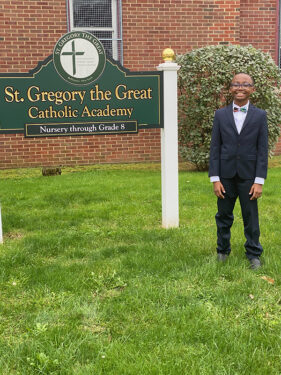
BELLEROSE — When one of her students didn’t show up for the first day of school on Sept. 9, Principal Lynn Alaimo immediately contacted his mother. The child had been previously attending public school, but his mother opted not to send him back in September, enrolling him instead in St. Gregory the Great Catholic Academy.
On the phone, the mother told the principal that she couldn’t make the first tuition payment and didn’t feel right sending her son to class when she owed the school money.
Right there on the phone, Alaimo worked out a payment plan for the parent. “He can’t miss his first day of school,” she told the mother.
Alaimo’s dedication is an example of how schools in the Diocese of Brooklyn go the extra mile to accommodate former public school parents enrolling their children in Catholic school.
Schools are seeing an increase in the number of students coming in from public schools as the de Blasio administration struggles with reopening classes during COVID-19.
In the last week of September, 274 new children enrolled in Catholic schools, according to Ted Havelka, director of enrollment management and financial assistance for the superintendent of schools.
That would not be an impressive number at other times of the year, like August, when parents register their children for a new school term. “But it’s an extraordinary number the last week in September when schools have already been open a couple of weeks,” Havelka told The Tablet.
The influx of newcomers is helping, according to Havelka, who notes that 40 percent of the diocese schools have either stabilized or increased their student populations this term.
“We’ve picked up students,” Alaimo told the Tablet. Her school now has an enrollment of 236 students.
One of those new students is Earl Carter IV, whose mother, Ericka Valere, decided to leave the public school system because its remote learning model wasn’t working.
“I just felt it wasn’t well organized,” she told The Tablet.
“He is a self-starter,” Valere said of her son, but she noticed toward the end of the school year in June that he was having problems.
“He missed the student-teacher interaction,” she said. “I followed St. Gregory on their website the whole summer. They really had a plan.”
Education officials aren’t satisfied with simply upping the enrollment numbers. Officials are also eager to spread the word about tuition assistance to entice parents who might be reluctant to consider Catholic education due to costs.
There are scholarships available through Futures in Education, the non-profit organization that provides tuition assistance. In some cases, there is financial help provided by the child’s school.
“If you’re a parent looking to send your child to Catholic school and you’re sincere about needing help, we’ll find a way to make it happen,” said Msgr. David Cassato, vicar for Catholic Schools.
Msgr. Jamie Gigantiello, vicar for Development, said parents should not let finances stand in the way.
“Futures in Education has given out $100 million over the last 25 years. You send your child; Futures can help them,” he told The Tablet.
At Futures, the programs include the Teddy J. Forstmann Scholarship and the Be an Angel to a Student program.
The Forstmann Scholarship, administered through the Children’s Scholarship Fund, provides up to 75 percent of funding (a maximum of $3,200) for tuition costs. The scholarship is open to students in grades K-8 who are new to Catholic schools. Parents must apply for the scholarship with Futures.
Be an Angel to a Student allows an individual donor to provide a portion of the funding toward a specific student’s tuition in a K-8 school. A typical donation is $2,000 a year.
“We work closely with our schools and our parishes. They’re doing most of the heavy lifting. They explain the options to parents,” Futures Executive Director John Notaro told The Tablet.
Schools are doing their part, according to Notaro: “Individual schools do work within their budgets to offer financial assistance.”
Futures provides, on average, $7 million in scholarships annually. This year, with COVID-19, “we gave out $8 million,” he noted.
“We want to help everyone 100 percent,” Notaro added.
Editor’s Note: For more information on scholarship opportunities, visit Futures in Education: https://futuresineducation.org/scholarships/
